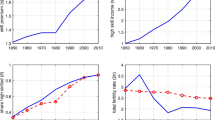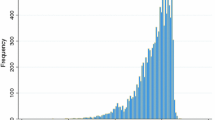Abstract.
This study examines households’ fertility variations in response to expected permanent shifts in the return to education. Wage premiums measure␣the return to education because their long-run movements are driven by factors exogenous to the fertility process. The results indicate that high education parents’ fertility responds negatively to changes in the expected return to college and negatively to changes in the expected return to high school. On the other hand, the fertility of low education parents does not vary with changes to expected returns to education. These results can be consistently interpreted within a standard quality/quantity model of endogenous fertility.
Similar content being viewed by others
Author information
Authors and Affiliations
Corresponding author
Additional information
I am grateful to seminar participants at Penn State University, Virginia Tech. University, the Economic Demography Workshop at the annual meeting of the Population Association of America and the Mid-West Macroeconomics Conference and well as to a helpful referee. Responsible editor: Junsen Zhang.




